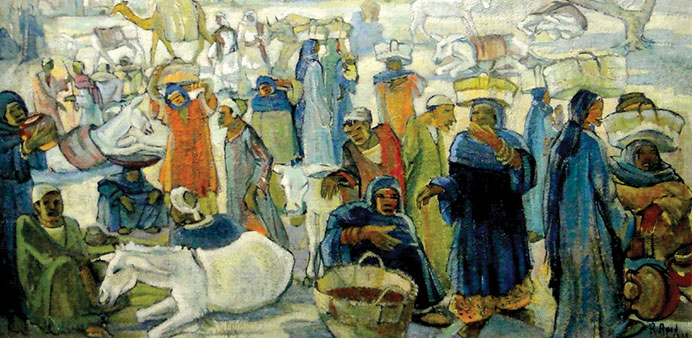DOCUMENTED: Ragheb Ayab’s The Village Market from the online encyclopaedia.
By Anand Holla
If you ever wanted to learn more about Arab artists, their histories and their journeys, but didn’t know where to start, you would do well to get started with Mathaf Encyclopedia of Modern Art and the Arab World.
The online treasure trove of a resource, courtesy Mathaf: Arab Museum of Modern Art, has turned out to be a robust, one-stop database of art in the Arab world.
The long-term project is being run in collaboration with Qatar Museums and Qatar Foundation. Initiated by Qatari artist, collector, researcher and Mathaf founder Sheikh Hassan bin Mohammed bin Ali al-Thani, as part of the development of Mathaf and knowledge around its collection, the online resource www.encyclopedia.mathaf.org has been gaining ground among art enthusiasts and the art community at large, ever since its beta version was launched last September.
“The bilingual encyclopaedia is a free online scholarly comprehensive resource that will provide basic facts and in-depth information on modern art of the Arab world,” the Mathaf says, “It aims to standardise the data on Arab artists and to encourage multiple perspectives on modernism in the Arab world while providing a comprehensive view on its development.”
The design is simple and navigation is easy. The research team at Mathaf commissions scholars and independent researchers to write encyclopaedia entries/biographies, under the direction of Professor Nada Shabout, consulting Director of Research at Mathaf. The biographies are accompanied by the artist’s artworks, list of exhibitions, list of awards conferred, further reading recommendations, videos, and photographs that include some rare images.
The encyclopaedia features an alphabetical artists’ index, an advanced search option and videos delving into the artists’ minds, and is steadily growing into a comprehensive collection of the stories behind the region’s most important artists and their artistry.
Considering the increasing interest in Arab art, the encyclopaedia has become a knowledge platform for art historians, researchers, scholars, university students, art professionals and translators seeking information on Arab modern artists, their styles, techniques, artwork, contributions, concepts, terminologies found in the Arabic art glossary, as well as areas of specialisation related to modern art in the Arab world and modernism in general.
“All peer-reviewed and translated entries are original and provide comprehensive documentation on Modern artists of the Arab world by academics and scholars in the field. Entries also include artists’ signatures for reference and authentication as well as artists’ photos, artwork images, and audio-visual material,” says Mathaf.
To get a sense of how understanding the Arab artists’ works and lives tells us the story of the region’s evolution, sample a glimpse into one of the recent biographies that have been put up. Iraqi artist Shakir Hassan al-Said (1925-2004) was a prolific and influential artist, writes Sonja Mejcher-Atassi. A founding member of the Baghdad Group for Modern Art in 1951, and the One Dimension Group in 1971, al-Said wrote art manifestoes for both groups.
“The manifesto he wrote for the Baghdad Group for Modern Art in 1951 was the first art manifesto of its kind in Iraq. It was read out at the group’s inaugural exhibition at the Museum of Ancient Costumes in Baghdad – an event that is considered by some the true birth of modern art in Iraq. The manifesto gives voice to the group’s commitment to both heritage and modernity. Its emphasis on the culture of the region drew inspiration from Islamic art, particularly Al-Wasiti’s 13th Century miniature paintings, but also from products of popular culture such as traditional carpets, as well as from the ancient civilisations of Mesopotamia,” points out Mejcher-Atassi.
“This entailed Arab artists distancing themselves from the previous course of modern art in the Arab world, which was perceived as following European models, and setting out to ground modern art more firmly in a local context. It marks a re-orientation in art that coincided with radical political change and the growth of Arab nationalism,” she explains.
From Lebanese artist Daoud Corm to Egyptian sculptor Adam Henein, from revolutionary Palestinian artist Sliman Mansour to Moroccan modernist artist Mohammed Melehi, the brightest talents of Middle Eastern art world come alive in these well-researched biographies.
Spurred by an aim to serve as a hub that supports knowledge exchange and network between researchers and scholars around the world, the encyclopaedia is well on its way to becoming the definitive guide to the region’s top artists and their works.



